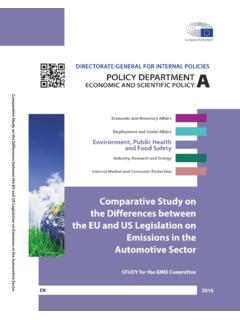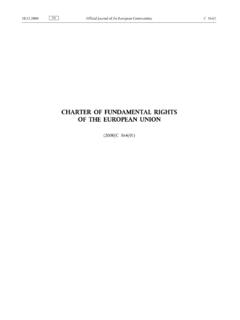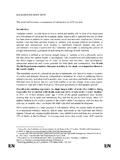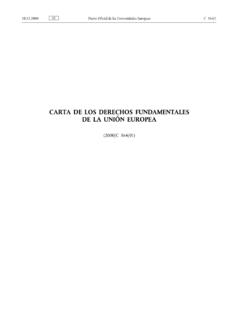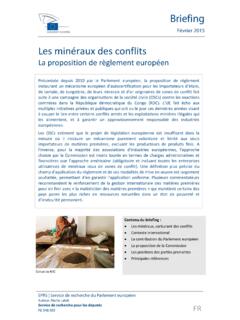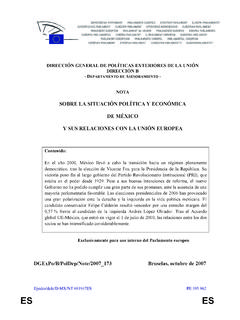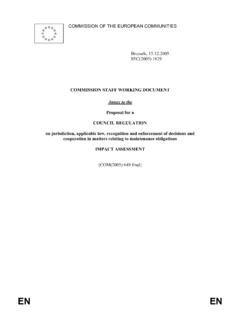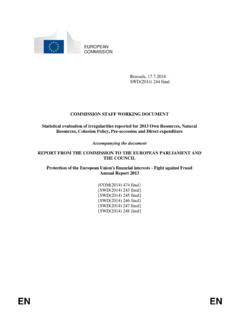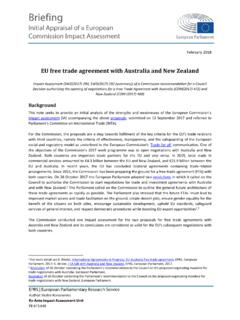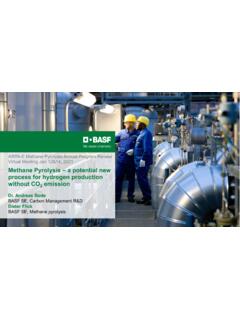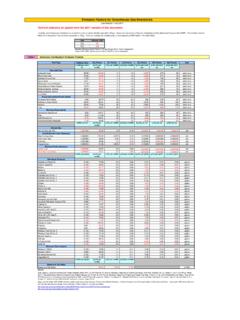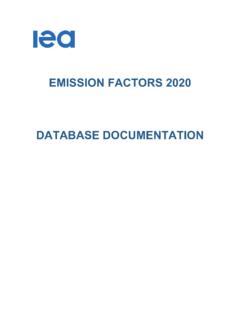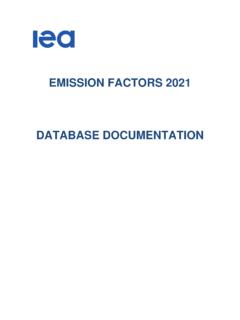Transcription of CO2 emission standards for heavy-duty vehicles
1 BRIEFING. EU Legislation in Progress CO2 emission standards for heavy-duty vehicles OVERVIEW. In May 2018, the Commission proposed a regulation setting the first-ever CO2 emission performance standards for new heavy-duty vehicles in the EU, as part of the third mobility package. It would require the average co2 emissions from new trucks in 2025 to be 15 % lower than in 2019. For 2030, the proposal sets an indicative reduction target of at least 30 % compared to 2019. Special incentives are provided for zero- and low- emission vehicles . The proposed regulation applies to four categories of large trucks, which together account for 65 %-70 % of co2 emissions from heavy-duty vehicles . The Commission proposes to review the legislation in 2022 in order to set a binding target for 2030, and to extend its application to smaller trucks, buses, coaches and trailers. In the European Parliament, the proposal was referred to the Committee on Environment, Public Health and Food Safety, which adopted its report on 18 October 2018.
2 Parliament voted on the report on 14 November. Trilogue negotiations were concluded on 18 February 2019 with an agreement that sets a legally binding 30 % reduction target for the average fleet emissions of new trucks by 2030. The Parliament adopted it during the April II 2019 plenary session, and the Council on 13 June. The Regulation was published in the Official Journal on 25 July and entered into force on 14 August 2019. Proposal for a Regulation of the European Parliament and of the Council setting CO2 emission performance standards for new heavy-duty vehicles Committee responsible: Environment, Public Health and Food COM(2018) 284. Safety (ENVI) Rapporteur: Bas Eickhout (Greens/EFA, the Netherlands) 2018/0143(COD). Shadow rapporteurs: Christofer Fjellner (EPP, Sweden). Damiano Zoffoli (S&D, Italy) Ordinary legislative John Procter (ECR, United Kingdom) procedure (COD).
3 Nils Torvalds (ALDE, Finland) (Parliament and Council Stefan Eck (GUE/NGL, Germany) on equal footing . Eleonora Evi (EFDD, Italy) formerly 'co-decision'). Jo lle M lin (ENF, France). Procedure completed. Regulation (EU) 2019/1242. OJ L 198, , pp. 202 240. EPRS | European Parliamentary Research Service Author: Gregor Erbach Members' Research Service PE August 2019 EN. EPRS | European Parliamentary Research Service Introduction On 17 May 2018, the European Commission adopted a proposal for a regulation setting the first- ever CO2 emission standards for heavy-duty vehicles (trucks) in the EU. There are around 7 million trucks operating in the EU-28. Annual registrations of new trucks in the EU increased by 45 % from 2010 to 2016, to around 380 000. Around 70 % of EU freight is transported by road. The road freight and passenger transport sector consists of over 600 000 mostly small and medium-sized enterprises (SMEs) and employs almost 3 million people.
4 The EU truck market is dominated by six manufacturers 1 that together hold an 88 % market share. Around million people are employed in truck manufacturing, repair, sales, leasing and insurance. The heavy-duty vehicle sector is characterised by many different vehicle categories, technologies, sizes and weights, as heavy-duty vehicles are typically customised for specific clients and uses. This range of different vehicle combinations makes it difficult to estimate important parameters such as fuel consumption and co2 emissions in a reliable and cost-effective manner. heavy-duty vehicles are responsible for 27 % of road transport co2 emissions and almost 5 % of EU. greenhouse gas emissions (2016 data). Since 1990, heavy-duty vehicle emissions have increased by 25 % mainly as a result of an increase in road freight traffic and, in the absence of new policies, they are projected to further increase.
5 EU transport is heavily dependent on oil (accounting for nearly 94 % of the energy consumed by transport in 2015, of which 89 % is imported). The Commission's energy union strategy presented in February 2015 envisages action to further decarbonise road transport, with a view to meeting the 2030 climate and energy goals. The European strategy for low- emission mobility, presented in July 2016, aims to improve transport- system efficiency by using digital technologies and smart road charging; it furthermore promotes multimodality, encourages the use of low- emission alternative energy for transport and outlines measures for moving towards zero- emission vehicles . The proposal is part of a larger set of measures to reduce GHG emissions in the transport sector and achieve a 30 % emission reduction by 2030 in the sectors covered by the Effort-Sharing Regulation. In order to achieve this target in a cost-effective manner, EU-wide emissions from road transport would need to fall by 25 % by 2030 relative to 2005, according to analysis by the Commission.
6 Under the Commission's baseline scenario, emission reductions would only be around 17 %, and around 21 % with the proposed post-2020 emission standards for cars and vans. The gap of 4 percentage points could be progressively closed by about one percentage point with the implementation of the proposed CO2 standards for heavy-duty vehicles . The remaining gap would be addressed through other additional policies with an impact on road transport co2 emissions . These policies include the minimum share of renewable fuels in transport in the revised Renewable Energy Directive, as well as the proposed Eurovignette, clean vehicles and combined transport directives. The EU has so far adopted several measures to reduce emissions from road vehicles . Binding emissions targets for new car and van fleets have been in place since 2012 and 2014 respectively. 2. However, co2 emissions and fuel efficiency of heavy-duty vehicles are not yet regulated at EU level, in contrast to countries such as the United States, 3 Canada, India, Japan and China, which have already set CO2 emission standards for heavy-duty vehicles .
7 In May 2017, the Commission published the first set of proposals of the 'Europe on the Move'. mobility package. With respect to heavy-duty vehicles , the package contained a proposal to set up a system for monitoring and reporting co2 emissions and fuel consumption (see next section), which was adopted in June 2018. The clean mobility package, presented in November 2017, contains proposals for post-2020 CO2 limits for cars and vans and for a revision of the Clean vehicles Directive, which addresses public procurement of clean and energy-efficient buses and trucks. Trilogue agreements have now been reached on these files. 2. CO2 emission standards for heavy-duty vehicles Existing situation co2 emissions from heavy-duty vehicles are currently not regulated at EU or Member State level. The following legal acts are relevant to the co2 emissions performance of heavy-duty vehicles and the transport sector.
8 Monitoring and reporting co2 emissions and fuel consumption In June 2018, Parliament and Council adopted Regulation (EU) 2018/956, which sets up a system for monitoring and reporting co2 emissions and fuel consumption of heavy-duty vehicles , introduced as part of the first 'Europe on the Move' mobility package. This system ensures the availability of data on which to base the proposed emission performance standards . Member States must monitor and report data about all new heavy-duty vehicles registered in a calendar year, while heavy-duty vehicle manufacturers must monitor and report information related to the co2 emissions and fuel consumption of vehicles . As of January 2019, Commission Regulation (EU) 2017/2400 requires manufacturers to calculate this information on the basis of a standardised simulation tool (known as 'VECTO'). The Commission will make the reported data publicly available, in a register managed by the European Environment Agency, with exceptions for sensitive data.
9 A similar monitoring and reporting system is already in place for light-duty vehicles . Weights and Dimensions Directive The Weights and Dimensions Directive (96/53/EC) limits the maximum weight of heavy-goods vehicles to 40 tonnes (44 tonnes in combined transport) and their length to metres in international traffic. It was amended by Directive (EU) 2015/719, which allows new heavy-duty vehicles with more rounded and aerodynamic cabins starting in 2022. Besides reducing CO2. emissions , this improves road safety and the visibility and comfort of drivers. On 18 May 2018, the Commission put forward a proposal for a decision to amend the directive so as to bring the starting date forward by three years from 2022 to 2019. Clean vehicles Directive The Clean vehicles Directive (2009/33/EC) aims to incentivise different procurers (subject to the EU. public procurement directives and the Public Service Regulation), to invest in environmentally friendly vehicles .
10 However, the 2015 Commission evaluation found that the results have been limited, due to the low market share of vehicles purchased in public procurement and to methodological issues. In November 2017, the Commission presented a legislative proposal for a revision of the directive, which aims to promote clean mobility solutions in public procurement tenders (purchase, lease, rent or hire-purchase of road transport vehicles , and public service contracts on public passenger transport by road and rail), and thereby raise the demand for and the further deployment of clean vehicles . For heavy-duty vehicles , the proposal uses a definition of clean vehicles based on alternative fuels (electricity, hydrogen, natural gas including biomethane), but includes the possibility to adopt a delegated act to use emission thresholds for heavy-duty vehicles after a future adoption of CO2 emission standards for heavy-duty vehicles .
